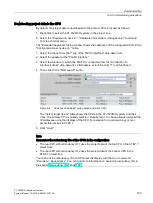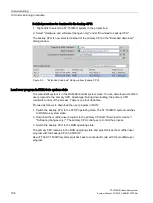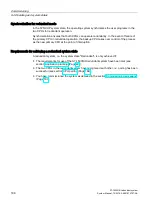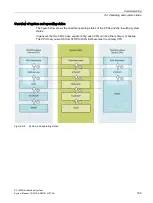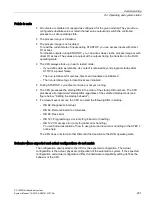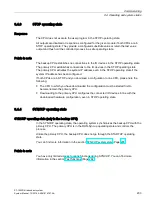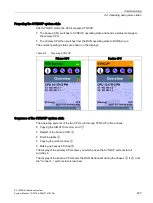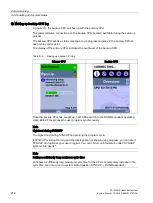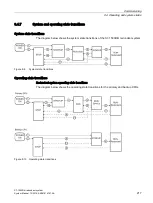
Commissioning
9.4 Operating and system states
S7-1500R/H redundant system
System Manual, 10/2018, A5E41814787-AA
205
RUN-Syncup operating state
In the RUN-Syncup operating state, the backup CPU synchronizes with the primary CPU.
The SYNCUP that temporarily affects the primary CPU (for example delay of asynchronous
services, cycle time extension through compilation of the load memory contents) runs
simultaneously in the backup CPU. You can find more information in the section SYNCUP
system state (Page 205).
The operating system synchronizes the work memory contents of the primary CPU
consistently at a cycle control point. During synchronization, the program cycle in the primary
CPU is extended in line with the amount of data to be synchronized and in addition to the
other cycle time of the application.
RUN-Redundant operating state
The redundant system is in the RUN-Redundant system state. Both CPUs process the user
program synchronously.
9.4.6
SYNCUP system state
Requirements
●
The versions and firmware versions of the two CPUs are the same.
●
There is a SIMATIC memory card in each CPU.
●
The PROFINET ring is closed.
●
There is at least one redundancy connection (fiber-optic cable) in the S7-1500H
redundant system.
●
Media redundancy role: One of the R/H-CPUs is the redundancy manager in the
PROFINET ring (CPU properties, Media redundancy area, default: "Manager (auto)" for
both CPUs). The IO devices are redundancy clients ("Client" configured in the properties).
●
Pairing for the two CPUs has been implemented.
●
The primary CPU is in the RUN operating state.
●
The execution of SYNCUP is not disabled (default setting).
●
No load functions are running.
SYNCUP system state
Synchronization in the SYNCUP system state ensures that the two CPUs can operate
redundantly. With the SYNCUP system state, the redundant system switches from RUN-
Solo to the RUN-Redundant system state. Afterwards, both CPUs synchronously process
the same user program.
Summary of Contents for Simatic S7-1500H
Page 1: ......



